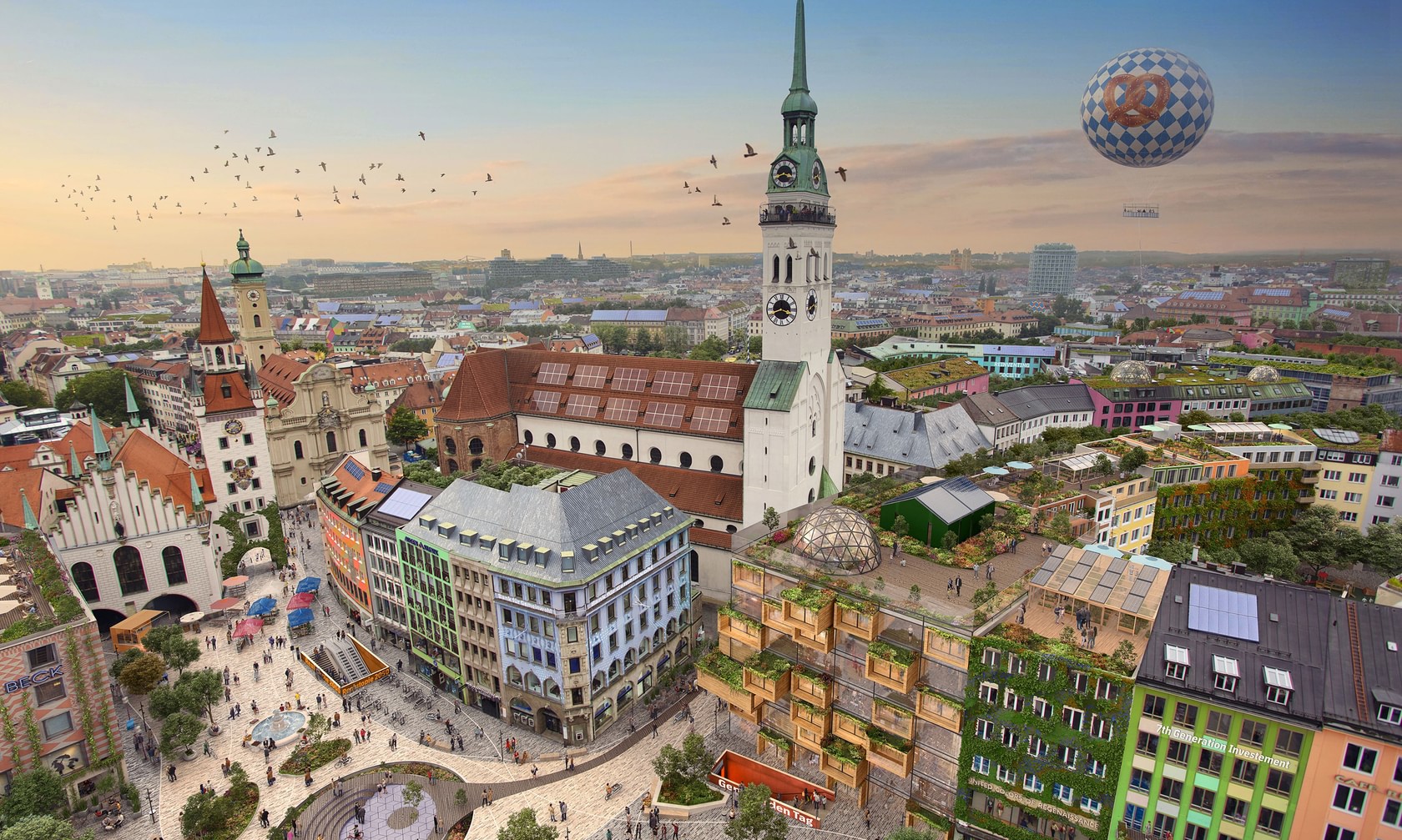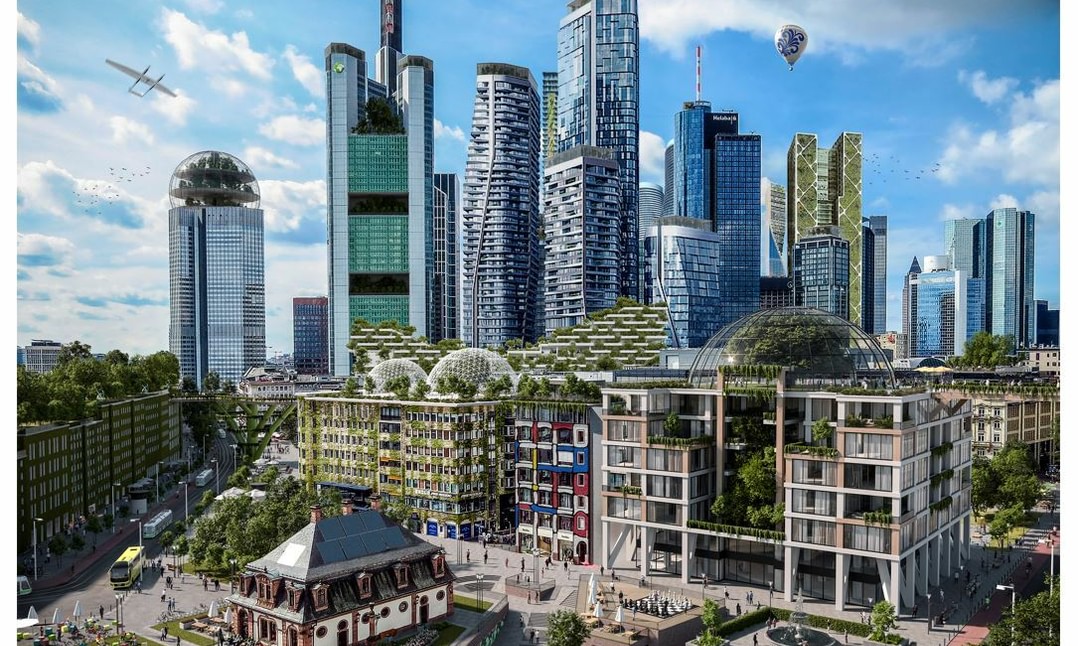
Realistic Utopias Bring Us Closer to the City of the Future Interview with Transformation Researcher Stella Schaller

Bilder, die die Zukunft zeigen? Wenn wir optimistisch sind, ja. Das Reallabor Reinventing Society forscht und erarbeitet utopische Konzepte für eine regenerative Gesellschaft. In diesem Jahr veröffentlicht das interdisziplinäre Team den Bildband „Zukunftsbilder 2045“. Darin sind Orte in Deutschland zu sehen – in ihrem größten zukünftigen Potenzial. Basierend auf aktueller Forschung und neuen Ideen taucht die Stadt etwa als lebendige Oase und Sehnsuchtsort auf.
In the research project „Zukunftsbilder 2045": History of a Successful Transformation", you and your team paint a picture of cities and other places in a climate-neutral Germany. These cityscapes are utopian for a reason. How can optimism help us in managing (future) challenges?
The media are often dominated by images of the future that make us feel powerless or angry, paralyze us, or make us despair. Many people feel helpless or associate sustainability with renunciation and high costs. That's where utopian images of the future start. They show how beautiful a regenerative transformation of our society actually looks, how it feels, what added value it brings. Images have a stronger effect than facts; they speak to very deep longings. They hold up a mirror in which we can see what could be different. Positive visions act as guiding stars to which we can align ourselves in order to cope with the complexities of everyday life and to have an orientation as to where we actually want to go. And they inspire us to think about versions of the future ourselves and align our own inner compass.

In den Medien dominieren oft Zukunftsbilder, die ohnmächtig oder wütend machen, uns lähmen oder verzweifeln lassen. Viele Menschen fühlen sich hilflos oder assoziieren Nachhaltigkeit mit Verzicht und hohen Kosten. Utopische Zukunftsbilder setzen hier an und zeigen auf, wie schön eine regenerative Umgestaltung unserer Gesellschaft überhaupt aussieht, wie sie sich anfühlt, was für einen Mehrwert sie bringt. Bilder wirken stärker als Fakten, sprechen ganz tiefe Sehnsüchte an. Sie halten uns einen Spiegel vor, in dem wir erkennen, was alles anders sein könnte. Die positiven Visionen wirken wie Leitsterne, an denen wir uns ausrichten können, um den komplexen Alltag zu bewältigen und um eine Orientierung zu haben, wohin wir eigentlich wollen. Und sie inspirieren, selbst über Zukünfte nachzudenken und seinen eigenen inneren Kompass auszurichten.
"The city of the future integrates harmoniously with the environment and its ecological cycles."
What do achievable utopian cities of the future look like? What differentiates them from the status quo today?
The city of the future has a positive impact on life, nature, health, creativity, and social interaction. It integrates harmoniously with the environment and its ecological cycles. That means it not only has green roofs and facades for biodiversity and city temperature. It actually functions in alignment with principles of regeneration, especially in terms of construction and energy production. For example, houses are built in such a way that they can be taken apart again afterward and their raw materials can be reused. The energy supply is secured by regenerative and decentralized sources – citizens can generate their own electricity on their roofs.
The city of the future is also human-centered. Today, public spaces are mostly associated with consumption and the urban structure is planned for cars. Public spaces, agoras, community gardens, and cultural venues are gaining importance – they strengthen democracy and quality of life as people meet, learn from each other, and create things together. Today, nearly 19 percent of urban space in Munich is reserved for car parking. In the desirable future, this space will be used better.


"If it remains rational constructs and abstract discourses, or if we get lost in the nitty-gritty, the necessary change will not happen. We are multi-sensory beings and need to be activated emotionally and in our hearts so that knowledge goes deeper and we really change habits."
How important is emotion as a key to sustainable transformation?
A regenerative society is based on new principles: regeneration instead of extraction, cooperation instead of competition, connectedness instead of separation. If these principles remain rational constructs and abstract discourses, or if we get lost in the nitty-gritty, the necessary change will not happen. We are multi-sensory beings and need to be activated emotionally and in our hearts so that knowledge goes deeper and we really change habits. That's why experiential formats such as imagery, stories, seminars, and workshops that address deeper levels and anchor new paradigms are so effective. Engaging with emotional barriers and resources releases creativity, vision power, and enthusiasm.
Which organizations do you include in your research, amongst others?
The "Bauhaus of the Earth" is an innovative organization that spreads a holistic approach to building, following the Bauhaus movement of the 20th century. The "regenerative cultures" movement, inspired by Daniel Christian Wahl, has also made enormously valuable contributions to urban design and inspired me a lot personally. We are also evaluating demands from a wide variety of environmental groups such as GermanZero and associations such as the Common Good Economy ("Gemeinwohlökonomie") and the Donut Economy to develop integral and systemic approaches for cities.
What's your favorite city as a good example?
A utopian city, of course! Regenera.city is a fictional city that lands on earth. In a virtual online world, you can explore it and get to know its functional principles in a playful way. I also like our own vision of a climate-neutral Stuttgart in the year 2045 – biophilic architecture, walkable roof gardens, and plenty of space for sports and creativity make us want to shape our future.
Any closing comments?
We're happy to connect with new partners, sponsors, and cities that want to join us on the way into a great future!

